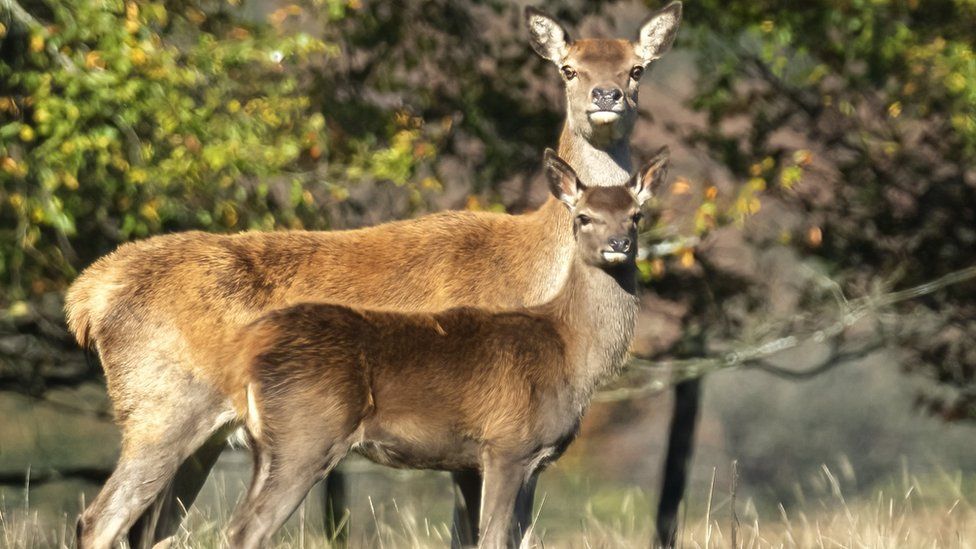
The loss of predictable weather patterns is "causing chaos" for nature, according to the National Trust.
It warns climate change is upsetting the regular rhythm of the seasons, making plants and wildlife more susceptible to disease.
The effects can be seen across the estates the National Trust manages.
This seasonal "baseline shift" is disrupting the annual behaviours of animals in particular but also impacting trees and plants, it said.
"The incremental shifts we're experiencing in terms of our seasons extending may not feel like much in a 12-month period, but over a decade the changes are extremely significant", said Ben McCarthy, head of Nature and Restoration Ecology at the National Trust.
2023 saw a series of temperature records, with the warmest June and highest sea temperatures ever recorded around the coast of the UK.
An unusually warm winter allowed pests and diseases to thrive.
Meanwhile low water levels in rivers, lakes and reservoirs - caused by a lack of rain coupled with the high temperatures - has been a factor in increased algal blooms.
On some occasions this has led to mass fish deaths as oxygen levels crash, causing them to suffocate.
And there were dramatic storms too, with storms Babet and Ciaran damaging landscapes and coastlines around the country.
You may have noticed the impact the changes in the seasons are having in the parks around your home or in your garden.
Grass needs to be mowed much later into the year, for example.
The National Trust rangers and gardeners report it's because of the increasingly warm and wet conditions at its sites in England, Wales and Northern Ireland.

Warm temperatures have also prompted some shrubs to come into bloom early, making them susceptible to sudden cold snaps - affecting pollinators, and the birds that feed on their seeds.
The UK's most iconic tree, the oak, could be particularly hard hit by the rising year-round temperatures, Mr McCarthy warns.
Cold snaps are getting shorter, which often doesn't leave enough time to kill off diseases.
For example, the oak processionary moth, whose caterpillars infest oak trees, thrive in these shorter cold spells making the oaks more vulnerable to attack from other parasites, he says.
The moth species has been migrating steadily northwards through Europe from their traditional home in the Mediterranean as the continent's climate warms.
Warmer winters could also impact our heathlands, the Trust says, allowing the heather beetle to take hold, killing off huge areas of the plant.
Animals which hibernate, like dormice, are especially threatened. They emerge from their winter sleep earlier and can quickly use up their vital remaining stores of energy.
Rangers have noted that red deer in some areas are becoming sexually active later in the year, so calves are born in the autumn rather than the summer.
"They're unable to get the fat reserves on to get them through the winters," Simon Powne, National Trust Wildlife Manager at Holnicote Estate explains.
"These weather conditions take the heat and energy out of anything and they're just not capable of surviving. So we're seeing a higher mortality rate."
But the UK has got off relatively lightly in terms of extreme weather in recent years compared to other countries, says Keith Jones, the National Climate Change consultant at the National Trust.
He points to the searing temperatures and heatwaves that have devastated parts of Europe this year and warns the UK is likely to experience increasingly extreme weather in years to come.
"We can't allow ourselves to be lulled into any sense of false security. In the near future we are likely to experience a combination of drought and high temperatures as well as high rainfall and floods - and we need to get ready for this new "norm", Mr Jones says.
We can build increased resilience into the UK's landscapes and ecosystems, the Trust says.
One example is the effort to return a Somerset river to how it was before humans started interfering with it.
Over the years the course of the river Aller on the Holnicote Estate in Somerset had been straightened and deepened. Now, it's free again to meander. A 1.2km long section has been filled in, with the water being left to find its own path through the floodplain, creating more than seven hectares of wetland.
The aim is to slow the river's flow, allowing more water to be held in the landscape.
"Let the water do what it wants to do," explains Jo Neville, the National Trust's Water Advisor for Southern England and Wales. "And what it wants to do is make this amazing habitat with channels all the way through the landscape, pools, ponds, wetlands."
The project will help combat flooding and drought, as well as increasing the diversity of wildlife. What is more, this new boggy landscape can store more carbon over time.
"At Holnicote we literally saw more nature move back in, within just three months of the project's completion as this new complex waterscape started to "bed in" and thrive," explains Mr McCarthy.
Related Topics
https://news.google.com/rss/articles/CBMiN2h0dHBzOi8vd3d3LmJiYy5jby51ay9uZXdzL3NjaWVuY2UtZW52aXJvbm1lbnQtNjc3MDU4MTLSATtodHRwczovL3d3dy5iYmMuY28udWsvbmV3cy9zY2llbmNlLWVudmlyb25tZW50LTY3NzA1ODEyLmFtcA?oc=5
2023-12-27 04:46:11Z
CBMiN2h0dHBzOi8vd3d3LmJiYy5jby51ay9uZXdzL3NjaWVuY2UtZW52aXJvbm1lbnQtNjc3MDU4MTLSATtodHRwczovL3d3dy5iYmMuY28udWsvbmV3cy9zY2llbmNlLWVudmlyb25tZW50LTY3NzA1ODEyLmFtcA
Tidak ada komentar:
Posting Komentar